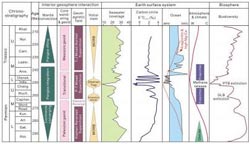The biggest mass extinction and Pangea integration

Relationships between geosphere disturbances and mass extinction during the Late Permian and Early Triassic are shown.<br><br>Credit: ©Science China Press<br>
Their study shows that Pangea integration resulted in environmental deterioration which further caused that extinction. Their work, entitled “Mass extinction and Pangea integration during the Paleozoic-Mesozoic transition”, was published in SCIENCE CHINA Earth Sciences.2013, Vol 56(7).
The Pangea was integrated at about the beginning of Permian, and reached its acme during Late Permian to Early Triassic. Formation of the Pangea means that the scattered continents of the world gathered into one integrated continent with an area of nearly 200 million km2. Average thickness of such a giant continental lithosphere should be remarkably greater than that of each scattered continent.
Equilibrium principle implies that the thicker the lithosphere, the higher its portion over the equilibrium level, hence the average altitude of the Pangea should be much higher than the separated modern continents. Correspondingly, all oceans gathered to form the Panthalassa, which should be much deeper than modern oceans. The acme of Pangea and Panthalassa was thus a period of high continent and deep ocean, which should inevitably induce great regression and influence the earth's surface system, especially climate.
The Tunguss Trap of Siberia, the Emeishan Basalt erupted during the Pangea integration. Such global-scale volcanism should be evoked by mantle plume and related with integration of the Pangea. Volcanic activities would result in a series of extinction effects, including emission of large volume of CO2, CH4, NO2 and cyanides which would have caused green house effects, pollution by poisonous gases, damage of the ozone layer in the stratosphere, and enhancement the ultra-violet radiation.
Increase of CO2 concentration and other green house gases would have led to global warming, oxygen depletion and carbon cycle anomaly; physical and chemical anomalies in ocean (acidification, euxinia, low sulfate concentration, isotopic anomaly of organic nitrogen) and great regression would have caused marine extinction due to unadaptable environments, selective death and hypercapnia; continental aridity, disappearance of monsoon system and wild fire would have devastated the land vegetation, esp. the tropical rain forest.
The great global changes and mass extinction were the results of interaction among earth's spheres. Deteriorated relations among lithosphere, atmosphere, hydrosphere, and biosphere (including internal factors of organism evolution itself) accumulated until they exceeded the threshold, and exploded at the Permian-Triassic transition time. Interaction among bio- and geospheres is an important theme. However, the processes from inner geospheres to earth's surface system and further to organism evolution necessitate retardation in time and yields many uncertainties in causation. Most of the processes are now at a hypothetic stage and need more scientific examinations.
Corresponding author:
YIN Hongfu
hfyin@cug.edu.cn
See the article: Yin H F, Song H J. Mass extinction and Pangea integration during the Paleozoic-Mesozoic transition. Science China: Earth Sciences, 2013, 56: 1791-1803
http://earth.scichina.com:8080/sciDe/EN/10.1007/s11430-013-4624-3
Science China Press Co., Ltd. (SCP) is a scientific journal publishing company of the Chinese Academy of Sciences (CAS). For 50 years, SCP takes its mission to present to the world the best achievements by Chinese scientists on various fields of natural sciences researches.
Media Contact
More Information:
http://www.scichina.orgAll latest news from the category: Earth Sciences
Earth Sciences (also referred to as Geosciences), which deals with basic issues surrounding our planet, plays a vital role in the area of energy and raw materials supply.
Earth Sciences comprises subjects such as geology, geography, geological informatics, paleontology, mineralogy, petrography, crystallography, geophysics, geodesy, glaciology, cartography, photogrammetry, meteorology and seismology, early-warning systems, earthquake research and polar research.
Newest articles

Properties of new materials for microchips
… can now be measured well. Reseachers of Delft University of Technology demonstrated measuring performance properties of ultrathin silicon membranes. Making ever smaller and more powerful chips requires new ultrathin…

Floating solar’s potential
… to support sustainable development by addressing climate, water, and energy goals holistically. A new study published this week in Nature Energy raises the potential for floating solar photovoltaics (FPV)…

Skyrmions move at record speeds
… a step towards the computing of the future. An international research team led by scientists from the CNRS1 has discovered that the magnetic nanobubbles2 known as skyrmions can be…




















